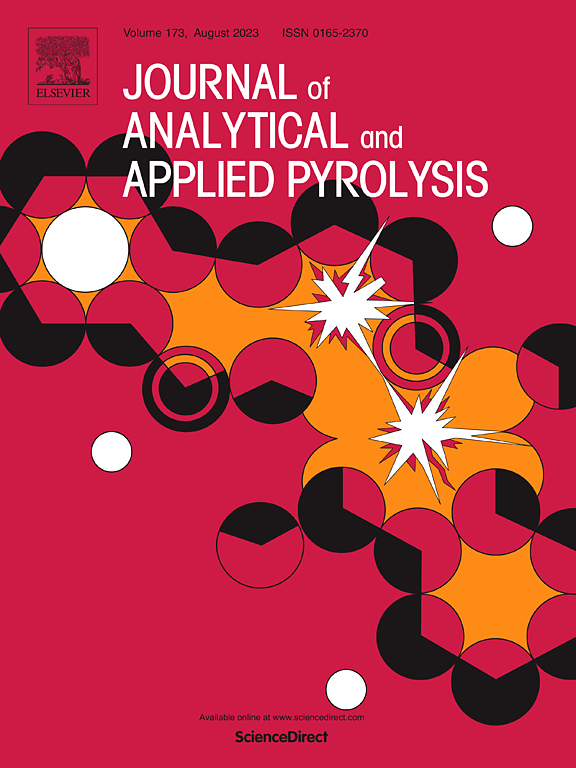Co-pyrolysis of adhesive waste and pine sawdust for resource recovery
IF 5.8
2区 化学
Q1 CHEMISTRY, ANALYTICAL
引用次数: 0
Abstract
The rapid increase in global waste generation, driven by factors like population growth and urbanization, has created significant challenges in waste management. This situation highlights the urgent need for sustainable waste management strategies focused on resource recovery. Concurrently, the rising use of adhesives, linked to improved living standards, has contributed to adhesive waste, complicating transportation and cleaning due to its high viscosity. To address this issue, incorporating biomass into adhesive waste can effectively lower its viscosity, facilitating the management of large amounts of waste. This study explores the viability of co-processing adhesive waste with pine sawdust through pyrolysis under various conditions like temperatures, heating rates, and mixing ratios, analyzing their co-pyrolysis characteristics. The results of this study indicated that temperature influences the composition of pyrolysis oil, favoring the formation of olefins and cycloolefins. Higher heating rates aid in adhesive waste depolymerization, increasing gas production while reducing pyrolysis oil output and enhancing olefin and cycloolefin proportions. Key compounds in the pyrolysis oil including C7H8, C8H10, and C8H12, exhibit diverse responses to temperature changes, with C7H8 decreasing and C8H10 and C8H12, initially increasing and then decreasing, suggesting that optimal temperature levels enhance product purity. Moreover, adjusting the pine sawdust content affects the activation energy for pyrolysis, impacting pyrolysis residue and gas generation. An appropriate mixing ratio can enhance adhesive waste pyrolysis and promote the re-polymerization of pyrolysis products. These findings highlight the importance of optimizing co-pyrolysis conditions to boost bio-oil yield and quality, facilitating efficient adhesive waste processing by mitigating viscosity issues.
胶粘剂废弃物与松木屑共热解资源化利用
在人口增长和城市化等因素的推动下,全球废物产生量迅速增加,给废物管理带来了重大挑战。这种情况突出表明迫切需要以资源回收为重点的可持续废物管理战略。与此同时,随着生活水平的提高,粘合剂的使用量不断增加,这也导致了粘合剂的浪费,由于其高粘度,使运输和清洁变得复杂。为了解决这一问题,将生物质加入粘合剂废物中可以有效降低其粘度,便于大量废物的管理。本研究探讨了在不同温度、升温速率、混合比等条件下,胶黏剂废弃物与松木屑共热解的可行性,分析了其共热解特性。研究结果表明,温度影响热解油的组成,有利于烯烃和环烯烃的生成。较高的加热速率有助于粘合剂废料解聚,增加产气量,同时降低热解油产量,提高烯烃和环烯烃的比例。热解油中的关键化合物C7H8、C8H10和C8H12对温度变化的响应不同,C7H8降低,C8H10和C8H12先升高后降低,说明最佳温度水平提高了产品纯度。调节松木屑含量会影响热解活化能,影响热解渣和产气。适当的混合比例可以增强胶粘剂废弃物的热解,促进热解产物的再聚合。这些发现强调了优化共热解条件的重要性,以提高生物油的产量和质量,通过减轻粘度问题促进有效的粘合剂废物处理。
本文章由计算机程序翻译,如有差异,请以英文原文为准。
求助全文
约1分钟内获得全文
求助全文
来源期刊
CiteScore
9.10
自引率
11.70%
发文量
340
审稿时长
44 days
期刊介绍:
The Journal of Analytical and Applied Pyrolysis (JAAP) is devoted to the publication of papers dealing with innovative applications of pyrolysis processes, the characterization of products related to pyrolysis reactions, and investigations of reaction mechanism. To be considered by JAAP, a manuscript should present significant progress in these topics. The novelty must be satisfactorily argued in the cover letter. A manuscript with a cover letter to the editor not addressing the novelty is likely to be rejected without review.

 求助内容:
求助内容: 应助结果提醒方式:
应助结果提醒方式:


